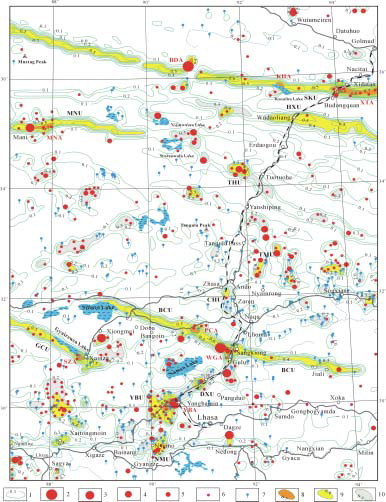Golmud-Lhasa Railway Geological Survey
NUMERICAL MODELINGAND STABILITYASSESSMENT OF TUNNELS
Tests on mechanical properties, numerical modeling of stress field and assessment of engineering stability were done for the Kunlun, Fenghuoshan and Yangbajain tunnels. Mechanical tests provided parameters such as density, Poisson ratio, elastic modulus, freezing expansion ratio, shearing strength, extensional strength and compressional strength of the major rocks in the vicinity of each tunnel. These parameters are useful for design and construction of all the threee tunnels.

Fig.23 Map showing contoured values of the present tectonic activity and classification of crustal stability along Golmud-Lhasa railway
Explanation: 1-isobath contour grade of present tectonic activity; 2-Ms≥8.0 earthquake; 3-Ms 7.0-7.9 earthquake; 4-Ms 6.0-6.9 earthquake; 5-Ms 5.0-5.9 earthquake; 6-Ms 4.0-4.9 earthquake; 7-unstable region; 8-hotspring; 9-present lake. The unstable regions are: SKU-south Kunlun, HXU-Hohxil, MNU-Mani, THU-Tuotuohe, TMU-Tanggula, BCU-Bengco, DXU-Damxung, YJU-Yangbajain and GCU-Gerenco. The degree of tectonic activity (α) is graded using 4 major factors: slip-rate of active fault (Vi), Richter scale of earthquake (Mi), temperature of hotspring (Ti) and tectonic strain (εi) where αi = (Vi/Vmax + Mi/Mmax +Ti/Tmax +εi/εmax)/ αmax for finite unit i as large as 7.6km×7.6km. The tectonic strain came from finite elementary modeling of stress fields constrained by GPS and stress measurement data.
The mechanical parameters of rocks tested in the laboratory provided a key part for numerical modeling of the stress fields of tunnels, and in-situ stress measurements and 1:2000 scale mapping gave constrains for boundary conditions for numerical modeling. Shape and size of the various tunnels were analyzed by numerical modeling for the Kunlun, Fenghuoshan and Yangbajain tunnels respectively, giving stress fields in each situation (Fig.22) and leading to reasonable discussions on the assessment of engineering stability and suggestions for design and construction of the tunnels. It is concluded that the Kunlun, Fenghuoshan and Yangbajain tunnels are stable with the maximum stress reaching 10-18MPa after the construction of the designed tunnels, which is less than strength of rocks surrounding the tunnel and will not lead to rock bursts.




